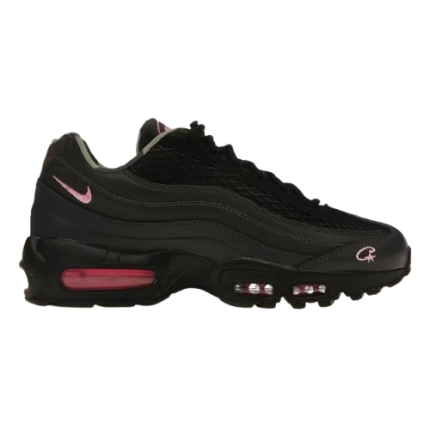Few sneaker silhouettes have etched themselves into global pop culture as deeply as the Nike Air Max 90 and Nike Air Max 95. Both models stand as milestones in the evolution of sneaker design, performance innovation, and streetwear culture. While they share the Air Max lineage, they differ in design philosophy, cultural influence, and historical context. Together, they form a compelling story of creativity, athletic performance, and global style.
The Air Max Legacy
To understand the impact of the Air Max 90 and 95, we must first appreciate the Air Max line. Debuting in 1987 with the Air Max 1, designed by the legendary Tinker Hatfield, the line introduced visible air cushioning technology. It was revolutionary—not just for comfort and performance, but for its bold design, proudly displaying its technology rather than hiding it.
The Air Max series evolved rapidly through the late ’80s and early ’90s, each new silhouette pushing the boundaries of sneaker design. In that progression, the Air Max 90 and Air Max 95 stand as two of the most iconic and beloved models.
Air Max 90: A Timeless Classic
Originally released as the Air Max III in 1990, the shoe was later renamed the Air Max 90. Designed again by Tinker Hatfield, it was a refinement of previous Air Max concepts with improved materials and a sleeker profile. Its defining visual element was the larger visible Air unit in the heel and the aggressive use of color blocking—most famously seen in the original “Infrared” colorway.
The Air Max 90 was made with runners in mind, using Duramesh uppers, synthetic overlays, and TPU panels for both performance and aesthetic appeal. Its wedge-like shape and exaggerated midsole gave it a sense of speed and motion, even while standing still.
But the Air Max 90 quickly transcended its performance roots. As hip-hop, skate, and street culture adopted the silhouette, the shoe found itself everywhere—from music videos to underground clubs and graffiti-covered alleyways. Its versatility made it a staple not only for athletes but also for stylists, collectors, and artists.
Today, the Air Max 90 is a lifestyle essential, available in countless colorways and collaborations. From Off-White to Patta, the model has remained relevant through reinterpretation, yet the core design has never strayed far from its ’90s roots.
Air Max 95: Breaking the Mold
Five years later, in 1995, Nike shook the sneaker world again with the release of the Air Max 95, designed by Sergio Lozano—a break from the Tinker Hatfield lineage. Inspired by human anatomy and the natural world, the shoe’s layered upper represented muscle fibers and sinew, while the spine-like back tab echoed the human vertebrae. It was a daring and divisive design that stood in stark contrast to anything that came before it.
Most revolutionary, however, was the use of forefoot visible Air—the first time Nike extended the Air unit beyond the heel. This enhanced cushioning and performance while reinforcing the shoe’s futuristic vibe.
The original “Neon” colorway, with its gradient gray tones and lime green accents, became instantly iconic. While it was technically built for performance running, the Air Max 95 found its greatest audience in urban environments—from New York to Tokyo to London.
In the UK, particularly, the AM95 became a cultural emblem. It was embraced by grime artists, football fans, and working-class youth, earning the nickname “110s” (after their original retail price of £110). The bold, aggressive look matched the attitude of a generation that wanted to stand out—and the AM95 delivered.
Comparing the Icons
While the Air Max 90 and Air Max 95 share the same DNA, they offer distinctly different experiences:
-
Design Language: The AM90 leans toward balance and simplicity, with clean lines and smooth transitions between materials. The AM95, in contrast, is more segmented and anatomical, offering a layered, textured appearance.
-
Performance Features: The AM90’s cushioning is focused in the heel with a visible Air unit, offering solid comfort for casual wear. The AM95 introduced forefoot Air units, providing a more performance-focused ride that influenced future models.
-
Cultural Identity: The Air Max 90 is universally loved—accessible, adaptable, and stylish across generations. The Air Max 95 is more polarizing but intensely loved by its core fanbase, especially in urban subcultures where it became a badge of identity.
-
Colorways and Collabs: The AM90 is known for its wide range of collaborations and lifestyle colorways, often with fashion-forward brands. The AM95, while less mainstream in its collaborations, has inspired some of the most cult-loved releases in sneaker history.
Influence on Sneaker Culture
The influence of both models goes far beyond footwear. They have inspired music, fashion, and art. From being referenced in rap lyrics to appearing on catwalks, these sneakers helped blur the lines between athletic gear and lifestyle essentials.
Moreover, they played a vital role in Nike’s dominance in the sneaker world. Both models have been consistently reissued, reimagined, and reinterpreted—proving their staying power across decades.
Final Thoughts
Whether you’re drawn to the timeless simplicity of the Air Max 90 or the bold innovation of the Air Max 95, it’s undeniable that both shoes are pillars of sneaker history. They represent different eras and attitudes but share the same legacy of challenging conventions and defining style.





